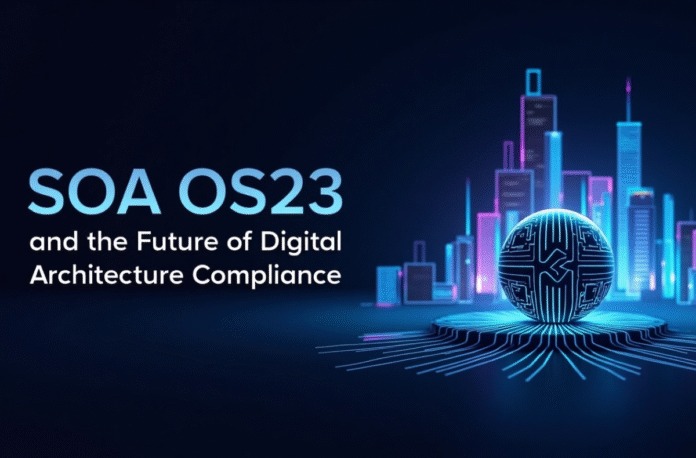In 2025, digital transformation is no longer optional. Enterprises are under increasing pressure to build agile, scalable, and secure systems capable of adapting to rapid technological shifts. Enter SOA OS23 — a modern evolution of service-oriented architecture that is redefining how businesses design and deploy software infrastructure.
From cloud-native compatibility to decentralized orchestration, SOA OS23 (Service-Oriented Architecture – Operating Standard 2023) brings a new level of efficiency, modularity, and resilience to enterprise IT.
What Is SOA OS23?
SOA OS23 is a next-generation software architecture built upon the principles of traditional service-oriented architecture (SOA) but modernized for today’s cloud-first, microservices-driven environments. Unlike monolithic systems, SOA OS 23 divides applications into autonomous, interoperable services that communicate through APIs and events.
Key Innovations Include:
- Microservice-native framework
- Event-driven message handling
- Decentralized identity modules (OAuth2.2 & DID)
- API standardization & zero-trust compliance
Key Features of SOA OS23
| Feature | Description |
|---|---|
| Microservices Architecture | Enables modular, independently deployable services |
| API Gateway | Manages traffic and data between services |
| Cloud-Native Compatibility | Supports Kubernetes, Docker, and serverless deployments |
| Security Framework | Built-in JWT, AES256 encryption, and role-based access control |
| Observability Tools | Integrates with Prometheus, Grafana, and OpenTelemetry |
| Service Orchestration | Workflow management with fallback and auto-healing rules |
| Polyglot Support | Compatible with multiple languages (Python, Go, Java, Rust, etc.) |
Why SOA OS23 Matters in 2025
As the digital landscape shifts toward edge computing, real-time applications, and multi-cloud environments, traditional SOA models fall short. SOA OS 23 addresses these challenges head-on by providing:
- Modularity: Rapid deployment and replacement of services
- Scalability: Individual services can be scaled based on demand
- Resilience: Auto-recovery from failures and performance bottlenecks
- Security: Zero-trust networks and encrypted service discovery
Benefits of SOA OS23 for Modern Enterprises
- 📈 Faster Development Cycles
- 🔒 Improved Security Protocols
- ✨ Greater Interoperability
- 🚀 Easier Cloud Integration
- 🌟 Optimized Performance under Load
Bullet Points:
- Develop in multiple languages using the same framework
- Launch updates without system-wide downtimes
- Seamlessly integrate with legacy systems
- Track service performance via real-time dashboards
- Enable secure collaboration across departments
Real-World Applications of SOA OS23
1. Fintech
- KYC, fraud detection, and transaction services operate as modular components
- Secure, real-time data handling via encrypted microservices
2. Healthcare
- Integrated patient records, diagnostics, and appointment systems
- HIPAA-compliant logging and identity management
3. Logistics
- Dynamic routing and inventory tracking
- Mobile-friendly APIs for driver and warehouse apps
4. Retail & E-Commerce
- Modular shopping carts, payment gateways, and recommendation engines
- Rapid updates to individual service modules
Comparing SOA Generations
| Generation | Core Features | Limitations |
| SOA (2000-2010) | XML, Service Buses | Monolithic, complex integration |
| SOA 2.0 | REST APIs, lightweight BPEL workflows | Stateless, weak schema validation |
| SOA OS23 | Event-driven, modular, decentralized | Requires skilled team, new governance model |
Tools & Frameworks Supporting SOA OS23
- Istio — Service mesh management
- Dapr — Portable runtime for service invocation
- Envoy — API gateway and control plane
- Jaeger + Prometheus — Tracing and observability
- gRPC + REST — Hybrid API support
Challenges in Adopting SOA OS23
| Challenge | Solution |
| Complex migration from legacy | Use adapters and wrap services via Dapr or gRPC |
| Service sprawl | Implement centralized service registry and observability |
| Security complexity | Enforce strict token rotation and audit trail monitoring |
Best Practices for Migrating to SOA OS23
- Perform a System Audit: Identify services, dependencies, and data flows
- Containerize Legacy Modules: Wrap older services into containers
- Use Event-Driven Triggers: Replace cron jobs with asynchronous events
- Govern with DevSecOps: Use SLAs and observability to define benchmarks
- Train Your Teams: Promote internal knowledge sharing and documentation
The Future Roadmap of SOA OS23
- AI Integration: Smart orchestration and predictive resource scaling
- Blockchain Compatibility: Decentralized identity & verification
- Edge Support: Optimized for real-time edge node communication
- Developer Ecosystem Expansion: SDKs, templates, and community forums
Conclusion: Why SOA OS23 Is a Strategic Investment
Whether you’re a CTO, DevOps engineer, or system architect, SOA OS 23 offers an adaptable, secure, and future-proof foundation for building resilient digital services. With its microservices framework, built-in observability, and enterprise-grade security, it addresses today’s most pressing IT challenges head-on.

Leave a Reply